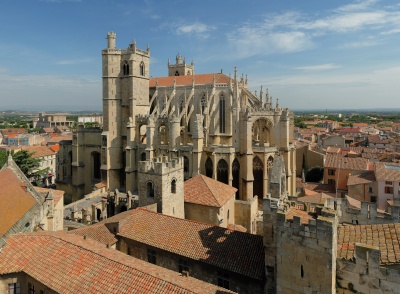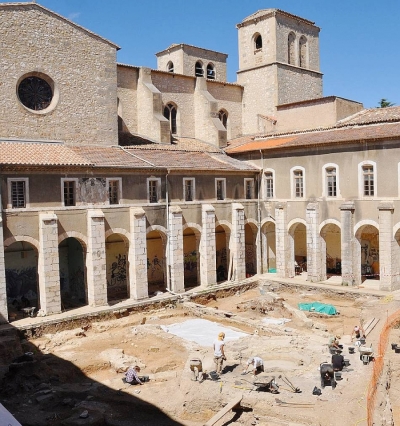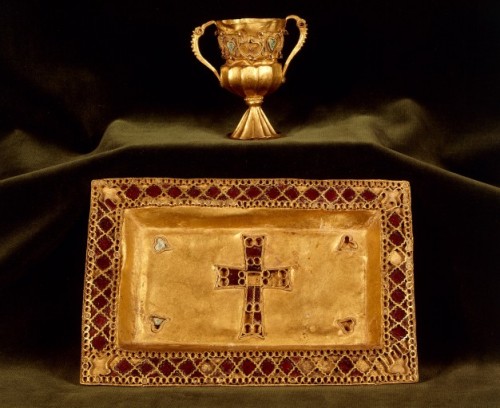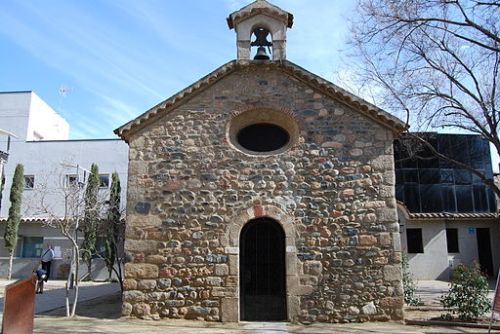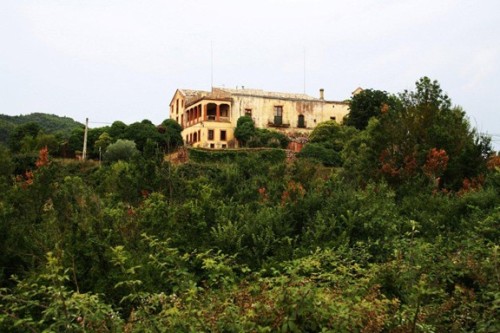I can’t now remember what it was I read or remembered that made me suddenly remember this document and decide to put it before you, but it may even have been writing the Widow Warlords post of a while back. Of course, when I actually dug up the charter in question it turned out to be slightly different from what I remembered, but there’s still so many points one can make with it that it seemed more than worth translating. So, this is the first will of Viscountess Adelaide of Narbonne, dated 4th October 978.1 (I don’t have a decent source to pin down the place-names, however, so most of them I leave in the Latin.)
“In the name of the Holy and Individual Trinity. Any man whatsoever, while he persists in this mortal pilgrimage, ought to raise his eyes up on high to the contemplation of the divine majesty, so that when he shall come to judgement, he shall be found justified. On account of which I in God’s name Adelaide, as I am exceedingly terrified of this day, order to be made [a document] in which I choose my executors [‘alms-givers’] so that, whatever they shall know of my will, that may they carry out. These are their names: Archbishop Ermengaud, & Raimond, & Vasadello, Seniorello, Bernard, Adalbert, Sigard de Petrulio.
Sadly the nunnery of Saint-Sauveur, entitled to the lion’s share of the properties listed below, doesn’t appear ever to have got finished… The lucky beneficiary would therefore have been this place, the Cathedral of Saints Just et Pastor, Narbonne, or at least its predecessor. By Benh LIEU SONG (Own work) [CC-BY-SA-3.0], via Wikimedia Commons.
“That holy work which I have begun outside [‘below’] Narbonne, to be built in honour of omnipotent God and the Holy Saviour, I leave to my sisters and to the lady Countess Arsinda, in such a tenor that my selfsame heredity of Vidiliano may revert to my sister Arsinda, and the selfsame alod of Tolomiano may revert to Ermessinda, and my heredity of Artimiciano may revert to Garsinda, and let them also hold these and possess them while they shall live; and if they bring the holy convent to completion, let the aforesaid alods all together revert thither in all integrity; & if they do not complete the aforesaid convent, after the death of Arsinda, let the selfsame heredity Vidiliano revert to the canons of SS Just & Pastor [Narbonne] in common; & the selfsame heredity of Artimiliano, after the death of Garsinda, revert in a similar way to the canons of Saint-Paul [Narbonne]; the selfsame alod of Tolomiano revert between Notre-Dame which they call la Grasse and Saint-Pierre which they call Caunes. The selfsame alod of Trolias with the selfsame part that I have in the same church, let revert to the monastery of Saint-Aniane. The selfsame alod of the villa of Boraxo let revert to the monastery of Saint-Pons [de Thomières], except the selfsame tower; let Aurice hold the selfsame tower with its manses that are tied to it while he shall live; afterwards indeed let it revert to the selfsame monastery of Saint-Pons. The villa of Bajas with its term, let Guadaud hold while he shall live, except those vineyards that others plant there; & when the convent of Saint-Sauveur shall have been made, after Guadaud’s death let it revert thither in all integrity; and if the convent shall not have been made, let revert those vines which come to my part in that villa to the guardian and keyholder of Saint-Paul who keeps the altar there; that villa with all its other heredity let revert in common to the canons of Saint-Paul. The selfsame alod that I have in the villa of Geminiano, which was Person’s and Daniel’s, and the selfsame vines that were Godrand’s, let hold the priest Dieudé while he shall live; afterwards indeed let it revert to the church of Sainte-Marie which they call Quadraginta. The selfsame alod that I bought from Bishop Arnulf in the term of Oveliano, with that same one of Taliaventos, let that now revert to the canonry of Saints Just & Pastor. The selfsame manse of Florenzac, which was Saint-Étienne’s, let revert to that same church. That alod which I have in the circuit of the castle of Saint-Martin, let revert to the monastery of Saint-Laurent. The selfsame alod of Cananiello let hold Golfred while he shall live; after his death let it revert, with the church of Sainte-Marie which they call Quart, to the monastery of Saint-Sauveur [Aniane]. That suburban settlement [burgus] which I bought from the woman Ebbo, let hold Hugues and Alulf while they shall live; afterwards let it revert to Saint-Paul, & let Saint-Paul hold among its possessions just as much the selfsame manse where the priest Nectar lives. The selfsame vines of Cesasinano, which Bon Vassal [or ‘a good vassal’] pledged to me, let revert to Umbert, as long as he redeems them from Bon Vassal. The selfsame manse of Aquaviva, which is in Lézat, let revert to Saint-Nazaire the see of Béziers. The selfsame manse within Narbonne which I bought from Saint-Pons, let revert to it.
The other major beneficiary, or at least the church that now stands on that site with a much more developed saint’s cult, Saint-Paul-Serge de Narbonne. Par GO69 (Travail personnel) [CC-BY-SA-3.0], via Wikimedia Commons.
“I also [wish that] this mercy and alms which I make on account of love for the highest eternal King, may be for the remedy of [my] soul, so that I may be able to avoid the punishment of [my] collected [sins], & attain to eternal happiness, and by His mercy the Creator may ignore the collected evils which I have done from the day of my birth until now, and at the same time the lord my man Matfred and my parents may provide for themselves a common mercy therein, and all my kinsmen and relatives, and all the faithful departed. The selfsame alod that I have between Biarum and Syronis, let revert to my son Ermengaud, and the selfsame church of Ductos which they call Sainte-Marie, with its parish, let revert to that same man. The villa Columbaria with its church of Saint-Pierre let revert to my son Raimond. The selfsame gold cups let revert to Ermengaud, and let him give fifty solidi for them to the canons of SS Just & Pastor which they may spend in common, & to the canons of Saint-Paul similarly 50 solidi, and to Saint-Nazaire the see of Carcassonne 50 solidi, & to Saint-Nazaire the see of Béziers 50 solidi. To Raimond let revert one silver chain, & two candelabra of silver, one with rolls and a belt, one with gold cublismonario [?], & let him give for those 50 solidi to Saint-Pons, & to Saint-Aniane 50 solidi.
Digs going on at another place that did all right from Adelaide, not the Saint-Sauveur she wished to build but that of Aniane, again in much later form
“Of the collected harvest of the vine and corn that I have in Florenzac, let the selfsame half revert to Ermengaud, of the other half the selfsame third to Saint-Thibéry [Agde]; the other two to Saint-Sauveur d’Aniane. Similarly of the harvest that I have in Nebozianense, let the selfsame half revert to Ermengaud, the other half let revert between the selfsame monks of Vabre and the monks of Joncelles. Of the harvest of Pociolo, & Urbanio, & Cavorras, let three parts be made; let one part be given to Saint-Michel de Galiaco, the other to Saint-Sauveur, & the other to Saint-Cecilia. If our convent shall have been completed, let revert thither my horses; if not, however, let 4 of them revert to Ermengaud, with the selfsame 2 mules, & 4 horses to Raimond. Of the other horses let three parts be made; one part let revert to the canonry of Saints Just & Pastor, another to the canons of Saint-Paul, the other to Saint-Aniane. Of the harvest of Villamagna, let half revert between Ermengaud and Raimond, of the other half let one third revert to Saint-Sauveur, the other two to Saint-Martin. Of the harvest of Vallemagnensis, & Caucenogilo, & Cogiano, let the selfsame half revert to Raimond; let them distribute the other half among churches and the poor. Of the harvest of Narbonne let revert half to the convent being built there; & if, God permitting, it shall have been constructed, I ask that my daughter may be abbess there, & to the selfsame woman let revert my jewellery, with the selfsame mancuses and golden things: the other half of the harvest let revert to Raimond. Let them make Archiberga & Adalberga & Belhomme & Aldeguer free and let each one of them be given five solidi. Of the chalice and offertory and 2 patens let the lord Ermengaud order one chalice to be made, & let him give it with the paten that Belhomme has to Saint-Paul. Let the cattle of Abuniano revert to the convent we are building. Let the cattle of Matucino along with all my swine revert to Ermengaud & Raimond, & let my aforesaid executors make a grand banquet of them. Of the substance they may have in their ministry, let them have for their work 20 solidatas, & afterwards whatever they may be able to find of my substance, let them faithfully divide it among churches and the poor, for the remedy of my soul; let them receive from me by God such a reward as the mercy for me for which they may implore Him.
I’m pretty sure that this chalice and paten are later medieval than is relevant for this post but they are firstly French and secondly absolutely gorgeous [edit: and, as it turns out, rather earlier than I thought, see comments…].
“This testament done the 4th Nones of October, in the 24th year of the reign of King Lothar. Signed Adelaide, who ordered this testament to be made and signed and asked to sign. Sig+ned Aldo, who is called Baroncel. Sig+ned Arlabaud. Sig+ned Guadaud. Sig+ned Isimbert. Sig+ned Ramnulf. Dieudé, notary, wrote these words.”
There’s obviously loads one could say with this document, especially if you do more than skim it as I guess you mostly just did. The particular bigger point that made me choose this one needs other information, so I’ll go into that last but meanwhile there are three things apparent just from this that are worth highlighting.
- Firstly, Adelaide comes over here as a patron of her city in a quite late Antique style. Most of the bequests favour either the cathedral (SS Just & Pastor) or the archbishops’ other church, St-Paul, with the little-known city monastery of St-Aniane coming in a reasonable third, and there’s also a clear expectation that it will be easy to sell things as needed, suggesting a ready market and in general an urban milieu. To me this looks different from my pet counts on the other side of the Pyrenees, except maybe the count-bishop Miró Bonfill’s investment in Besalú, but is that in fact because they have to rule differently? As an elderly city-based viscountess, her options to travel widely may have been limited compared to their more itinerant and military power.
- Secondly, the main impression this will gives is that Adelaide had a lot of stuff and was managing it quite closely, with known persons in charge of almost every bit of it and produce and livestock counted to nearly the head (the horses at least). But actually these things are relative: she bequeathed property in eighteen places, about three hundred and fifty solidi‘s worth of treasure and money, an unknown quantity of cows and pigs but apparently no more than one banquest would demolish and at least eleven and probably at least fourteen horses, the last being impressive because horses were almost all war animals at this time. That seems a lot but isn’t out of the realm of possibility for a major castellan in my Catalan documents, and Adelaide is an apparently sovereign viscountess. It is at least clear that there was more in the tank, as she was bequeathing produce from eight different estates here and only one of the actual estates is itself bequeathed, had you noticed? And in fact she also made a later will in which she bequeathed an almost entirely different set of properties, including the actual honor of the viscounty, which went to son Raimond.2 All the same, she doesn’t seem to have been in the top flight despite her position.
- The third thought is a similar one: there isn’t much hierarchy visible here, is there? One of these people holds a tower; otherwise, she, her late husband and the archbishop are the only obvious aristocrats here. There is no count, fine, but where are the castellans? Not appearing in this film, it would seem. Her six executors and five witnesses are quite possibly military men, someone must be riding those horses she has, but again there’s not a lot here to distinguish her from a rich castellan herself. Was there anyone holding office from her, we might wonder? If so she doesn’t say so. If we hark back to Jeffrey Bowman’s five qualities of female aristocratic power, it’s not clear that Adelaide had very many of them.3
But the gender angle is important, and it’s what initially made me notice this document. It’s not just that Viscountess Adelaide was herself a woman in power, her world contained many other women. Although her daughters don’t seem to merit naming, unlike her sons, one of them at least was hopefully to be an abbess, and her sisters were to support the building of the nunnery, not any male relatives. The figure who interests me most here is the countess, however. Did you notice her? It would be easy not to, since she doesn’t apparently get any property, but nonetheless she is there, Countess Arsinda of Carcassonne, helping out with the nunnery by uncertain means. I can’t help feel that it’s significant that she bears the same name as one of Adelaide’s sisters, too. The female namestock round here was restricted, as we know—this is after all another post about a woman called Adelaide—but these two reasons to believe some kind of connection do support each other.
A common focus of interest… The modern settlement of Saint-Pons de Thomières, which in the days of Viscountess Adelaide and Countess Garsinda was probably not much more than a new monastery. By Fagairolles 34 (Own work) [GFDL or CC-BY-SA-3.0-2.5-2.0-1.0], via Wikimedia Commons.
Anyway, when I first read this document I couldn’t help but notice the countess, because this was the sixth time she’d turned up in the relevant documentary collection.4 Nor is she by any means the only countess or viscountess appearing with such frequency. That collection was selective, but unless the Benedictines who put it together had a real thing for women in office there is something going on here. Furthermore, as this document shows, they were not women apart, but seem largely to have known each other. Here we see Viscountess Adelaide of Narbonne relying in part on her comital neighbour Arsendis; that’s the only connection between those two this anthology shows us, but Adelaide also shows up twice with Countess Garsinda of Toulouse, who also spent some time as a dowager ruler; the first time they concur they were both giving to Saint-Pons de Thomières, as did Adelaide again in her will, and the second time is Garsinda‘s will, in which Adelaide was the largest immediate beneficiary.5 Since Garsinda’s appearances here otherwise are pretty much only to do with Saint-Pons, which was clearly a concern of hers, and that’s presumably what governed the editors’ selection from documents otherwise now largely lost, we’re seeing just once here a connection that obviously meant more to both of these women, as did that between Adelaide and Arsendis to them for all that we only get a flash of it. I’m pretty sure more could be done to reconstitute these networks, which were probably largely constituted by marriages, but the picture I was already left with was a half-century or so of the French Midi in which a number of ageing women organised several aspects of society more or less in cooperation with each other, having got used to government with their husbands and seeing no immediate need as yet to hand over to their sons. Unlike some of the other cases we’ve looked at here of female power, there is something here that looks usual as well as frequent, and I wanted to bring it to wider attention.
1. Claude Devic & Jean Vaissete, Histoire Générale de Languedoc avec les Notes et les Pièces Justificatives. Édition accompagnée de dissertations et actes nouvelles, contenant le recueil des inscriptions de la province antiques et du moyen âge, des planches, des cartes géographiques et des vues des monuments, rev. Émile Mabille, Edward Barry, Ernest Roschach & Auguste Molinier & ed. M. E. Dulaurier, Vol. V (Toulouse 1872, repr. Osnabrück 1973), online here, Preuves : chartes et diplômes no. 130. It being online, I won’t type out the Latin for once; you can check, after all.
2. Ibid. doc. no. 151.
3. I’ve just linked to where I reference this paper, but because it could hardly be more relevant I’ll cite it here too: Jeffrey A. Bowman, “Countesses in court: elite women, creativity, and power in northern Iberia, 900–1200” in Journal of Medieval Iberian Studies Vol. 6 (London 2014), pp. 54-70, DOI: 10.1080/17546559.2014.883084. This post here is of course about the milieu in which almost all his example women grew up…
4. She occurs in Devic & Vaissete, Histoire générale de Languedoc Vol. V, Preuves : chartes et diplômes nos 79, 89, 103, 104.4, 104.6 & 130, which as per the nature of the collection are from several different archives any of which might show her up some more.
5. Ibid. nos 125 & 126 respectively; presumably Garsinda’s earlier arrangements were timore mortis ones.

